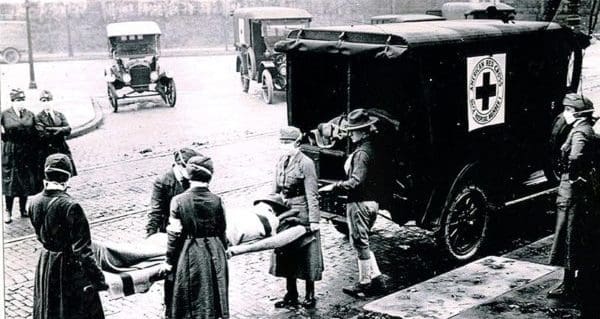 From the wet and windswept northwest of Ireland to rural southwestern Ontario, the flu pandemic of 1918 to 1920 was remorseless. My mother and my wife’s father lost siblings to an illness where death might come within 24 hours of first symptoms.
From the wet and windswept northwest of Ireland to rural southwestern Ontario, the flu pandemic of 1918 to 1920 was remorseless. My mother and my wife’s father lost siblings to an illness where death might come within 24 hours of first symptoms.
And sometimes it was particularly brutal. Historian John Barry has described it this way: “People could bleed not only from their nose and mouth, but from their eyes and ears.”
The pandemic respected no borders. Estimates of the global death toll range from 21 million to 100 million. That’s as much as five or six percent of the world’s population at the time.
The best guess for Canada (including Newfoundland and Labrador) is approximately 50,000 dead. Remote communities were hit very hard. The Oxford Companion to Canadian History speculates that isolated settlements along the coast of Labrador lost up to one-third of their population. Other estimates for some communities go as high as three-quarters.
The pandemic came in three waves, the first hitting in the early spring of 1918. But the second wave was the worst. The virus had now mutated to a “preternaturally deadly” form.
Appearing first in France, Sierra Leone and the United States in August 1918, the second wave made its Canadian debut at Victoriaville College, Que., on Sept. 8. October was the cruellest month. In one particular week, between 4,000 and 5,000 people died in Philadelphia alone.
Normally, a pandemic of this nature would be expected to focus on the most vulnerable demographic segments: the elderly and the very young. That, however, isn’t what happened.
Instead, it wreaked particular havoc on younger adults in the prime of life. Those aged 20 to 40 were especially susceptible.
A 2014 University of Arizona study hypothesized that this anomaly was attributable to a different childhood exposure experience for those born between 1880 and 1900.
They had been exposed – and thus built up antibodies resistant to – a H3N8 virus, which was different from that experienced by population cohorts born before or after. And because the pandemic strain was H1N1 rather than H3N8, their antibodies were ineffective.
The pandemic’s origin remains a matter of contention.
Noting a March 1918 outbreak at the U.S. military’s Camp Funston, one hypothesis traces the pandemic to Haskell County, Kansas, about 480 km west of the camp. Within three weeks of Funston’s first case, “more than 1,100 others were sick enough to require hospitalization, and thousands more – the precise number was not recorded – needed treatment at infirmaries scattered around the base.”
Funston was a training camp that processed a large number of soldiers. And with an average complement of more than 56,000 men, it had the critical mass to steadily funnel significant numbers to other locations for subsequent shipment to the European battle front of the First World War. It would have been an ideal transmission vehicle for the virus.
Another hypothesis points the finger at China.
In order to free up English and French manpower for the European front, thousands of labourers were recruited from northern China, where a respiratory illness had struck in November 1917. And compounded by the circumstances of their journey – across the Pacific to British Columbia, by rail in sealed cars across Canada, and then to Europe by ship – the labourers brought the virus with them.
Whatever the pandemic’s source, it was a catastrophe. Troops returning home, something that normally would have been a source of joy, only accentuated the problem.
People’s resilience was remarkable. Despite the inherent horror, they got on with life.
Perhaps it was down to timing, the fact that it occurred during the final days of the First World War and people were habituated to death.
Or maybe it was a matter of being accustomed to mass outbreaks of disease. In an era when medicine was much more primitive and public health was in its infancy, the social memory of epidemics like typhoid and cholera remained vivid. It was just something that happened from time to time.
“How are we coping with a similar situation today?
When something like this happens, the combination of round-the-clock news coverage, social media and modern health and safety expectations renders us more vulnerable to emotional stress. The stoicism of our grandparents and great-grandparents isn’t part of our makeup anymore.
Pat Murphy casts a history buff’s eye at the goings-on in our world. Never cynical – well perhaps a little bit.
The views, opinions and positions expressed by columnists and contributors are the author’s alone. They do not inherently or expressly reflect the views, opinions and/or positions of our publication.


